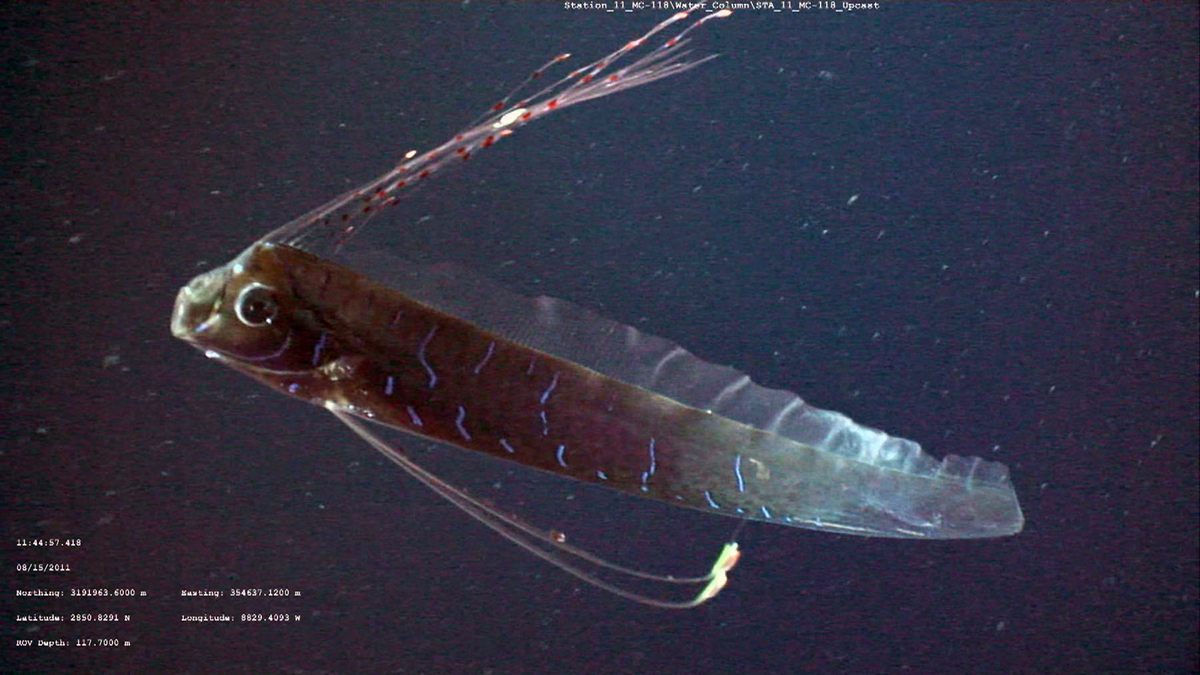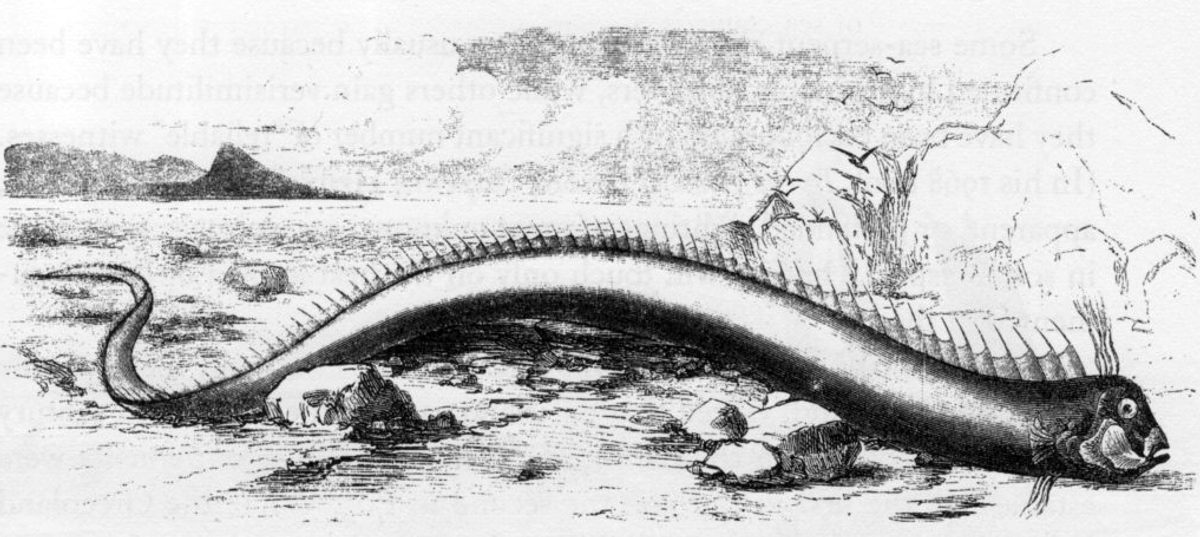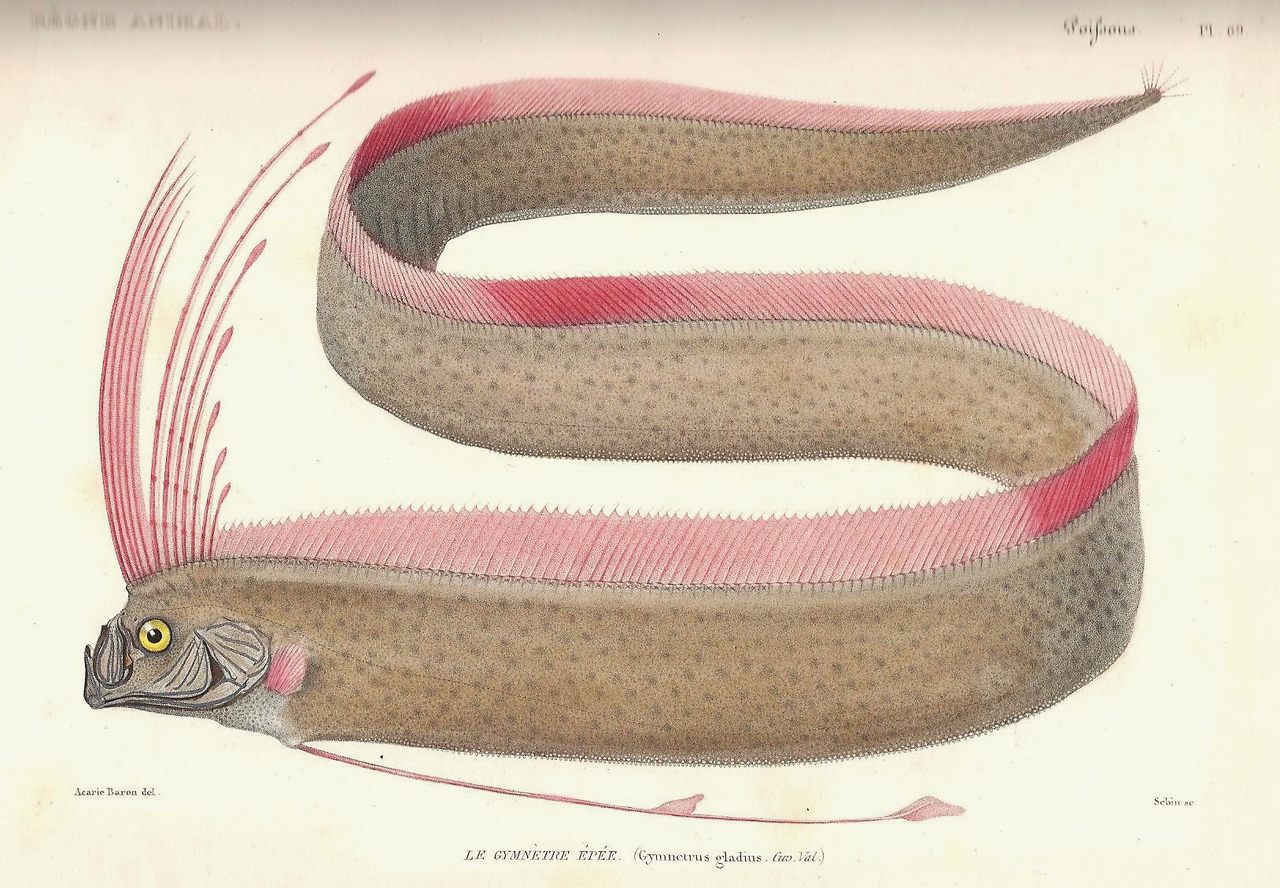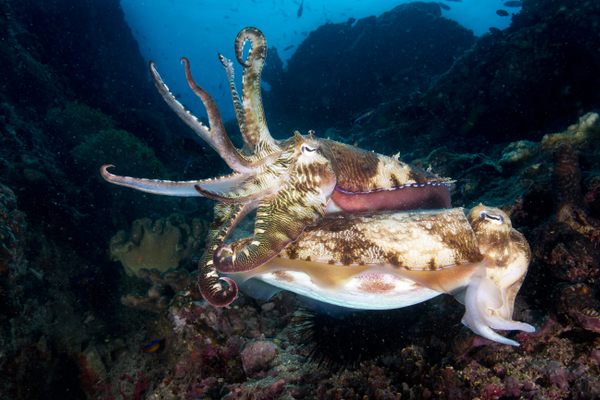The Legend of Japan’s ‘Earthquake Fish’
The serpent-like oarfish has long been considered an omen of natural disaster. Scientists are shaking up that old superstition.
The animal world is full of harbingers of doom—at least, according to superstitions. From the Tower of London’s ravens (whose departure would signal the fall of an entire nation) to the average black cat crossing your unlucky path, plenty of critters warn of woe. In Ominous Animals, we explore the lore—and the science—behind these finned, furry, and feathered messengers of impending calamity.
In July, divers off the coast of Ruifang, Taiwan, encountered a glimmering, serpent-like figure suspended vertically in the water, like a metallic party streamer glinting in the sun. The creature was docile as the divers swam around it in awe but, back on land, word of its presence spread ripples of panic.
In videos taken by the divers, the creature’s mirror-like, scaleless skin seems to blend into the water around it; the optical trick, along with the animal’s strategy of often swimming vertically, makes it nearly invisible to predators and prey above or below it. And keeping a low profile is important when you’re this big. While the animal off Ruifang, an oarfish, was just over six feet, they can grow to more than 35 feet, or the height of a telephone pole.

The unusual fish isn’t a serpentine sea monster, but, for some believers, it’s far more frightening. Oarfish typically live in deep water, at depths up to 3,300 feet. According to Japanese legend, the sight of them in shallow waters is an omen of earthquakes. The belief dates back to the 17th century, when the ghostly fish was known as ryugu no tsukai, a “messenger from the sea god’s palace,” according to the Japan Times.
In 2011, the largely forgotten “earthquake fish” legend surfaced after 20 oarfish washed ashore in the months leading up to Japan’s most powerful recorded earthquake, which caused a devastating tsunami. Since then, oarfish found on beaches or in shallow water have caused concern from the Philippines to California. The fears of coming quakes proved unfounded, but some scientists have hypothesized that there could be a connection. “Deep-sea fish living near the sea bottom are more sensitive to the movements of active faults than those near the surface of the sea,” ecological seismologist Kiyoshi Wadatsumi told the Japan Times.
There are plenty of anecdotes about animals of all shapes and sizes acting oddly before earthquakes. For example, the third-century Roman author Aelian wrote of an event several centuries earlier: In 373 BC, all the animals, from mice to beetles, fled the Greek city of Helike prior to an earthquake and subsequent tsunami that destroyed the city. Far more recently, in 2011, staff at the Smithsonian Zoo reported some resident primates made alarm calls and climbed trees in the moments before a 5.8-magnitude temblor struck the Washington, D.C. area.

Despite such reports, the link between odd animal behavior and imminent disaster is not supported by science, says London South Bank University zoologist Rachel Grant. In 2009, Grant was studying frogs at a site in Italy when they suddenly disappeared. Five days later, an earthquake hit. Afterward, the frogs returned. This phenomenon set Grant on a mission to discover whether certain animal behaviors actually signaled impending earthquakes. She focused on frog swarms, a natural synchronized mass migration of juvenile frogs that is sometimes seen as an omen of earthquakes in China. But when she and coauthor Hilary Conlan looked at reports from as far back as 1850 and crunched the numbers, the superstition didn’t hold up. “There is no link between frog swarms and earthquakes,” the researchers reported.
“I think what’s important is to understand what is really unusual behavior, and what is normal behavior,” Grant says. Frog swarms typically occur out of our view, she adds, “but occasionally they might coincide with an urban area and then people think, ‘oh, that’s unusual, it must predict something,’ because you don’t see it every day.”
Grant investigated the oarfish next, analyzing sightings over the past century in parallel with a separate team of researchers from Japan’s Tokai University. While Grant ultimately chose not to publish her results, both projects reached the same conclusion: Earthquakes and oarfish behavior aren’t related.

Mark Benfield, an oceanographer and ecologist at Louisiana State University, also believes any link between seismic activity and oarfish spotted along coasts is coincidental. He believes oarfish, like many deep-sea creatures, migrate vertically toward the surface at night to follow one of their favorite meals: krill. Sometimes a shift in currents may pull the fish onto the continental shelf and prevent them from returning to the depths; the oarfish washed ashore or in the shallows are typically dead, dying, or injured. Benfield has glimpsed oarfish alive and well in their deep-sea environment, via remotely operated vehicles, and cautions against thinking of them as rare and spectral messengers from the depths. “The reality is, there’s probably quite a sizable population of them out there,” he says. “We just don’t know about them.”
While the earthquake omen has been busted, it’s easy to understand why oarfish would attract such attention, with a dragon-like appearance fit for folklore. “They’re so eye-catching, that’s probably something to do with it as well,” says Grant. “And then they’re so huge that they take 12 people to hold—it’s spectacular—so I’m not surprised that there is a legend.”
Grant also suspects the legend endures because it provides a sense of order amid chaos. “I think it’s because [earthquakes are] an unpredictable event,” she says. “And people like to feel that they have some control over it.”























Follow us on Twitter to get the latest on the world's hidden wonders.
Like us on Facebook to get the latest on the world's hidden wonders.
Follow us on Twitter Like us on Facebook